Blog
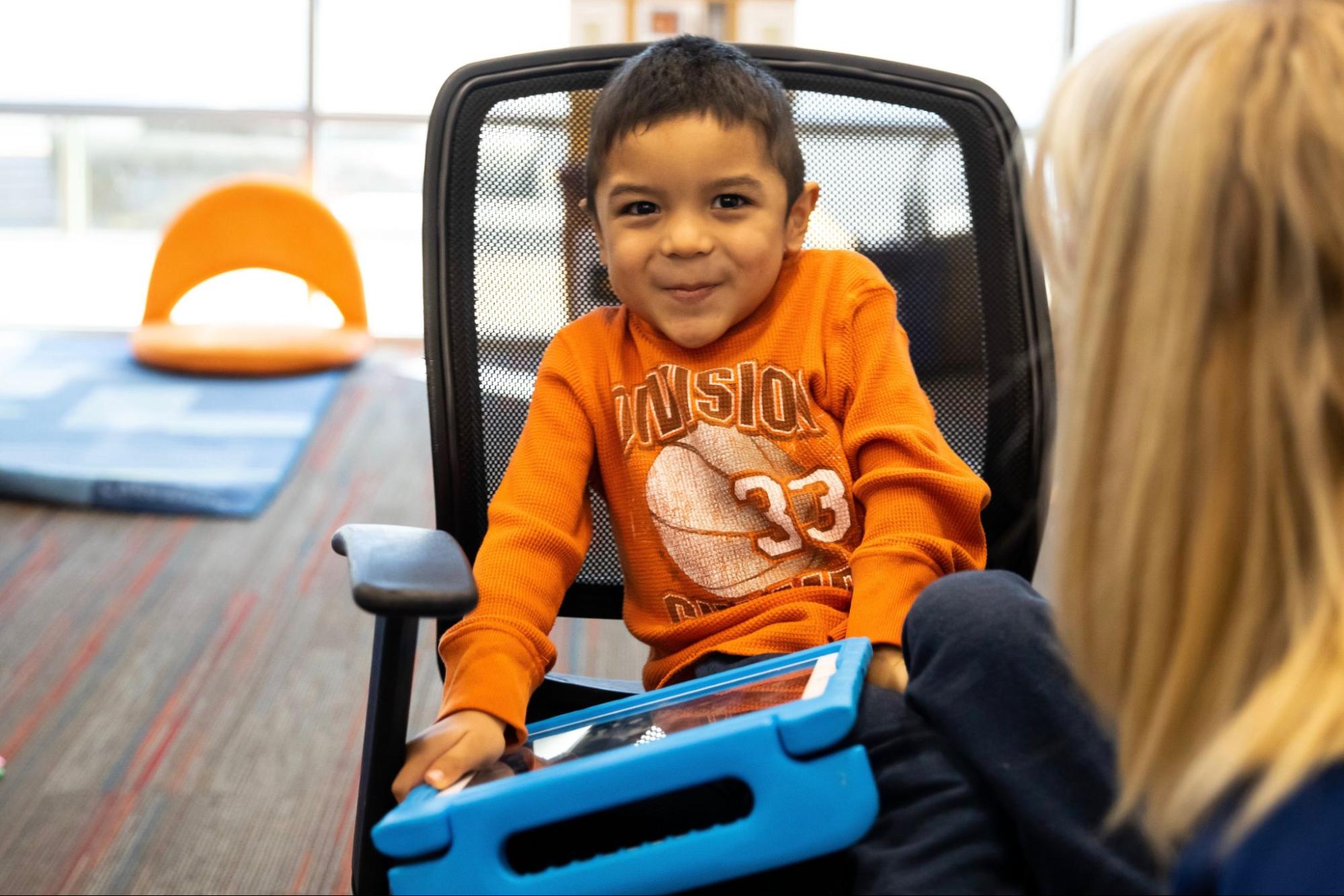
What are AAC devices and how can they help my child?
ABA Therapy, Feeding Therapy, Occupational Therapy, Physical Therapy, Speech Therapy
As human beings, we were designed to communicate. As communicators, we should be able to request, question, comment, express feelings and emotions, etc.
While some may not use their words to communicate, everyone should at least have the tools to be able to communicate.
AAC stands for Augmentative and Alternative Communication and it means all of the ways someone communicates besides talking. Augmentative means to add to someone’s speech and Alternative means to use something other than speech.
Some people use AAC devices throughout their life, but others may use AAC for only a short period of time.
When can AAC devices be utilized?
Signs a child could benefit from AAC devices:
- Child is nonverbal
- Child’s speech is hard to understand (i.e. child has childhood apraxia of speech, phonology disorder, etc.)
- Phonological Disorder occurs when phonological processes (patterns of sounds children use to simplify speech as they learn to talk) persist beyond the age when most typically developing children have stopped using them or when processes used are much different than what would be expected
- Ex. “wabbit” for “rabbit”, “tat” for “cat.” A longer list of examples of the phonological process and phonological disorders can be found here.
- Childhood apraxia of speech (CAS) is an uncommon speech disorder in which a child has difficulty making accurate movements when speaking. In CAS, the brain struggles to develop plans for speech movement
- Phonological Disorder occurs when phonological processes (patterns of sounds children use to simplify speech as they learn to talk) persist beyond the age when most typically developing children have stopped using them or when processes used are much different than what would be expected
- Child has a limited vocabulary of less than approximately 50 words (This is not always the rule, and you can talk with your therapist if it is something your child could benefit from.)
- Child has a high level of scripted phrases
- Scripting may be the child’s way of learning language and is sometimes called “echoing.” You can say something and they may just repeat it immediately after, or later in the day. The child typically has the knowledge of the words, but has difficulty putting it together to have a conversation.
Augmentative communication:
Augmentative means to add to someone’s speech.
We all use some sort of augmentative communication every day and we may not even realize it. And a lot of the time, people will understand what we are trying to communicate.
Therapists at Westside will especially use some of these communication tactics when working with children:
- Writing
- Gestures/signing
- Pointing to pictures
- Texting
- Google-Chat
- Choice Boards
- First-Then Visuals
- First-Then visuals are how our therapists can structure activities of what they want to do. “First we do this, then we can do that.” It is similar to a checklist and typically shows two pictures.
Alternative communication:
Alternative means to use something other than speech.
There are many different examples of Alternative communication, but a few of those include:
- Core Word Vocabulary boards
- Low/no cost, easy to find, light weight, high frequency vocabulary
- Can limit vocabulary, there is no voice output, but there are a lot of options for the board’s layout
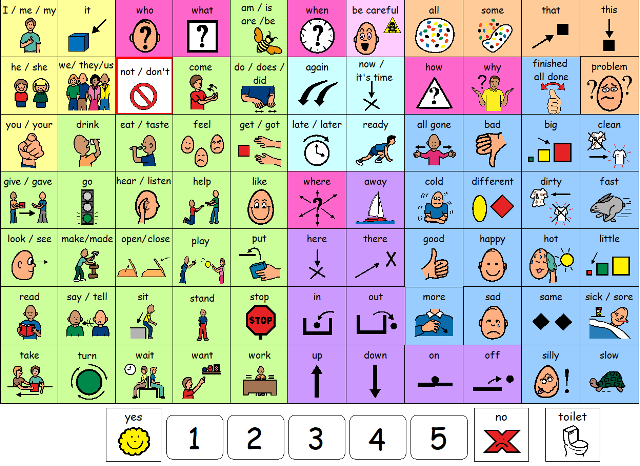
- Picture Exchange Communication System (PECS)
- Vocabulary is unlimited, pictures can introduce a concept of symbolic understanding, excellent for choices of foods/activities/toys
- Can limit communication functions, heavy to carry, lots of prep to create, trademarked system and must be trained
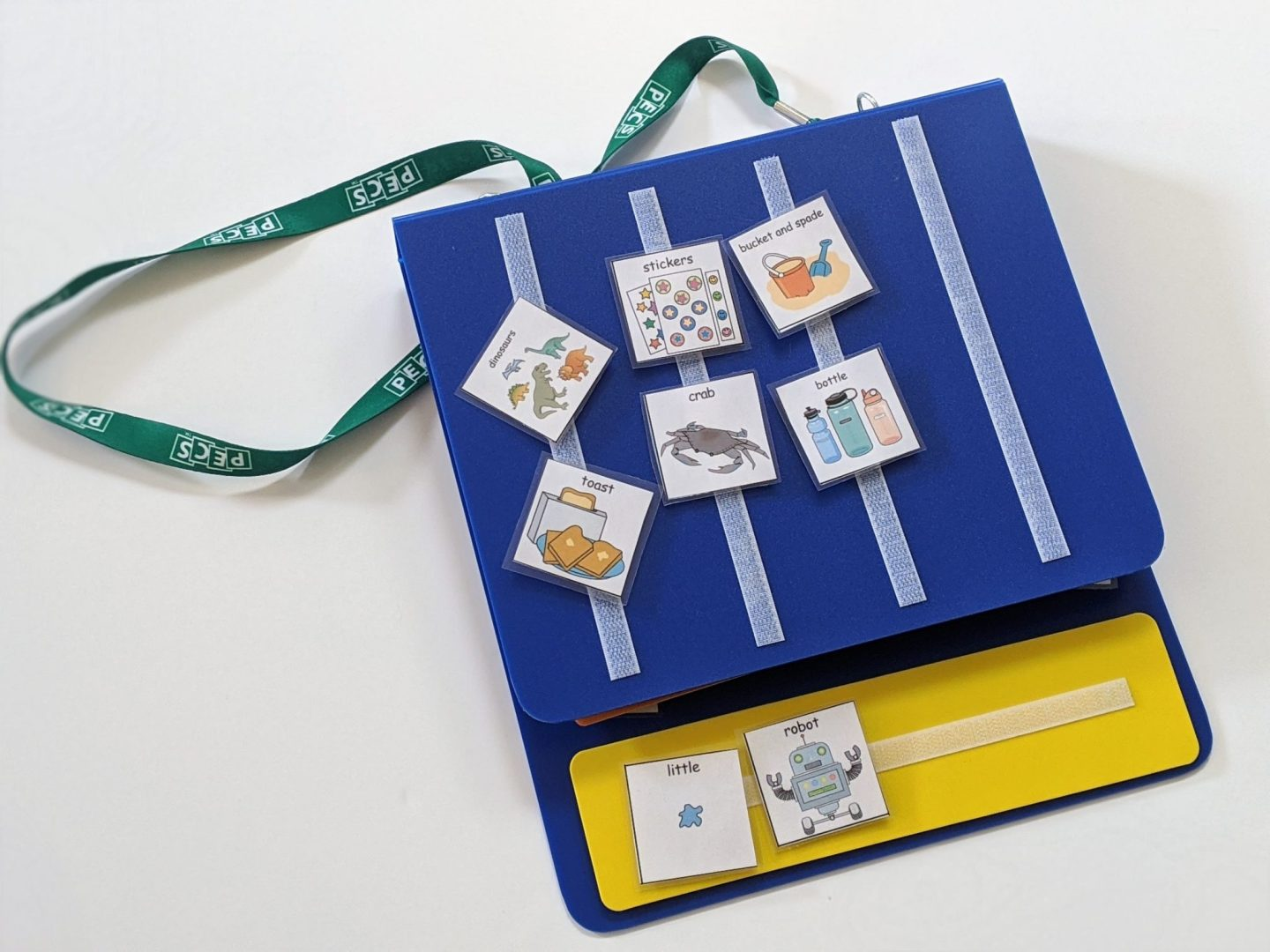
- iPad communication apps: LAMP, TouchChat, ProLoQuo2Go, Snap+Core
- Voice output, access to hundred of thousands of vocabulary words
- Can be expensive, do not come with tech support
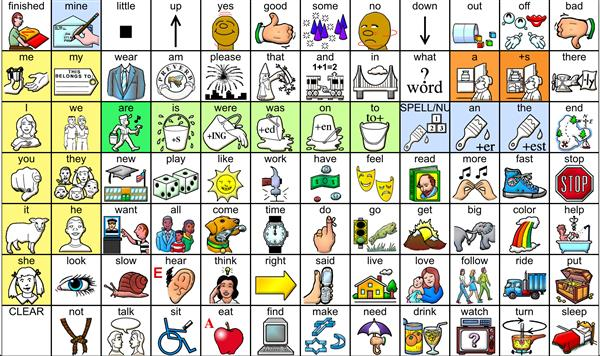
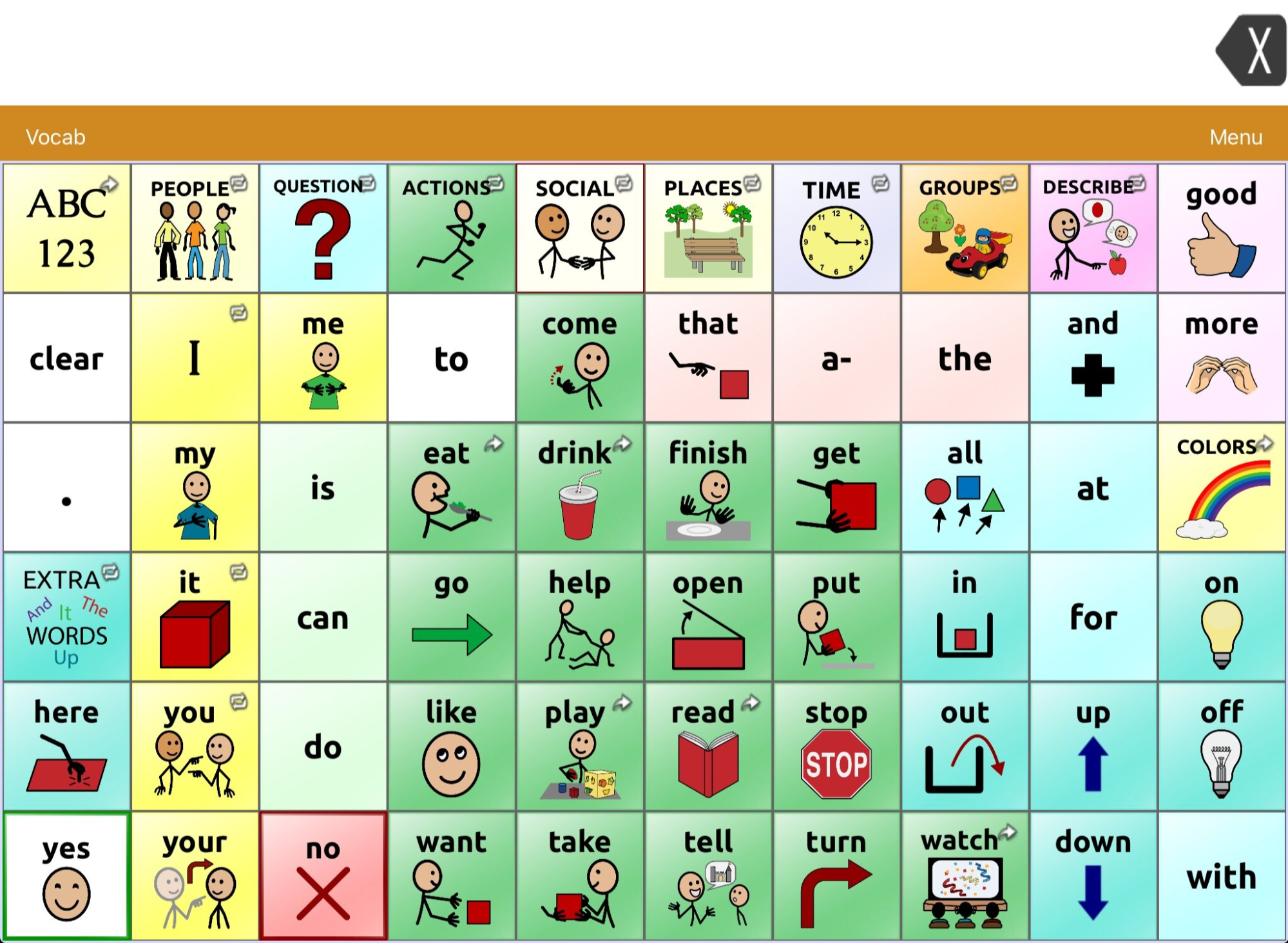
- Dedicated communication devices
- Voice output, tech support, robust vocabulary, durable
- Expensive, requires medical diagnostic and “prescription” to get insurance funding
Because there are a variety of different options available, children can pursue an AAC evaluation to determine what avenue might be the best fit for the child and family during a feature-matching process.
This process involves looking at the child’s communication strengths and matching it to a minimum of 3 technologies, tools (i.e., keyguard, touchguide, styluses), and access methods (i.e., direct selection, eye gaze, head tracking) for trial over multiple weeks.
The therapist, client, and family spend time with each device and at the end of the trial period, decide on the most appropriate technology and tools by looking at motivation, communication autonomy, and communication efficiency.
More AAC devices that are used at Westside:
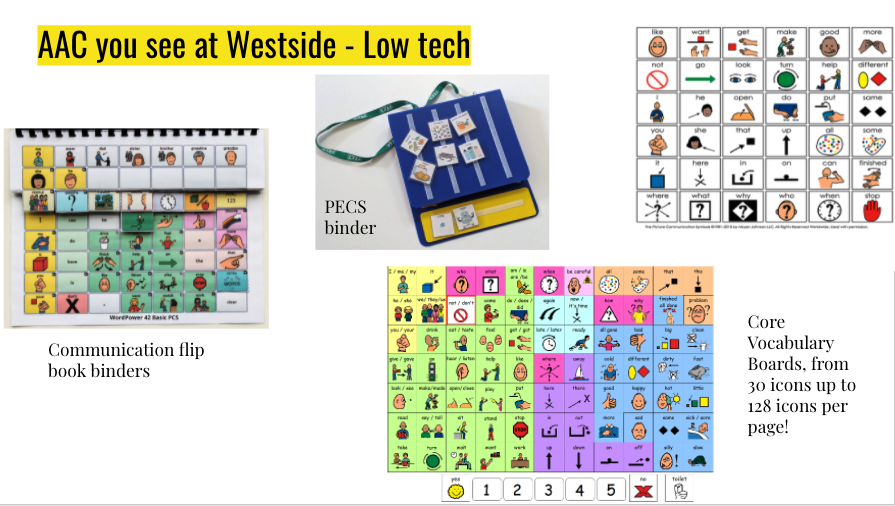
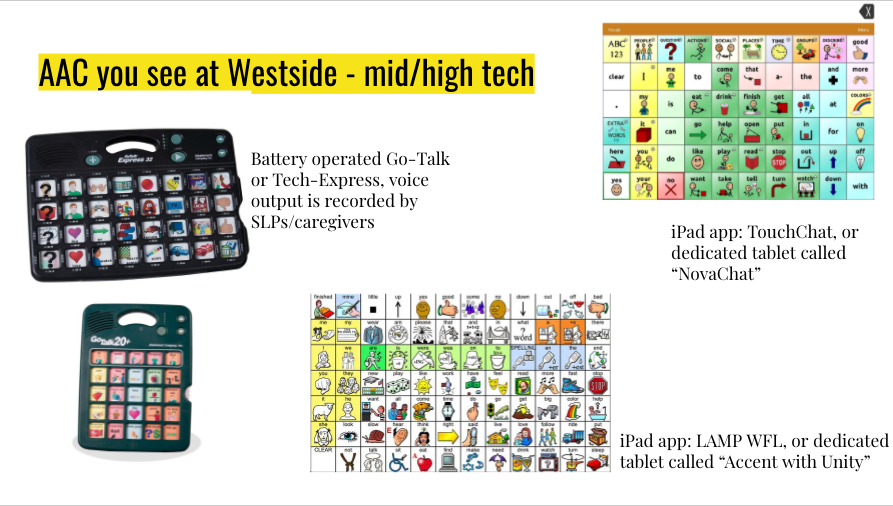
Clarifying misunderstandings about AAC devices:
Some believe that using AAC hinders verbal speech, but that is not the case. In some instances, it can actually support verbal speech as it gives additional feedback via verbal cues and a direct verbal model of the vocabulary word when learning the vocabulary term.
Children also do not need to be a certain age or have intact cognition to benefit from AAC. It will not limit the child’s verbal development. AAC has progressed and now children have access to different types of AAC so children with more significant cognitive impairments can successfully use AAC systems.
AAC devices are also not a “last resort” in speech-language intervention. AAC should be considered for anyone having difficulty accessing language, no matter their age or amount of intervention received.
AAC devices allow individuals the opportunity to practice using language in real life situations and are essential for development when verbal communication is challenging.
When should AAC be implemented and how to model
The best way parents, families, school teams, etc. can help implement the AAC system is to model, model, model!
Always have AAC devices available to the child throughout the day. Use a variety of activities and differing environments, and model language on the system for the child as they are learning it.
Below are three videos Westside speech therapists like to use that explain the implementation of AAC devices and the importance of modeling.
Model throughout the day, and, as mentioned above, especially during real, meaningful and motivating situations. You can also model in conversations and show how you can use different words to communicate different messages.
You also do not have to model every word you say and it does not need to be perfect.
Also, Make. it. fun!
Using AAC devices during…
Play:
Using AAC devices is not the activity. It is the communication modality. Have the “talker” out and available.
Our therapists will tend to pick one or two words to model that they say often.
- Go: bubbles, car, slides, climbing, jumping, scooter boards
- On: puzzles, blocks, Legos
- In: tunnel, puzzles, container play toys
If a kid is playing, a lot of the time our therapists will label different objects and toys, or label the color or description.
Ex: Tiger, dinosaur eat, go car, pop bubbles
They can use all sorts of nouns, verbs and adjectives to help the child go from single words to short phrases.
In Occupational Therapy:
- Give directions
- Go + up
- Go + down
- Put + in
- Take + out
- Describe sensory experiences
- Like
- Don’t/not like
- Stop
- More
- Same
- Different
- Fast
- Slow
- Requesting assistance and activities (making choices)
In ABA Therapy:
- Manding (request a want or need)/tacting (a comment on something we see, hear, smell, touch, etc.)
- Make requests and label toys and foods using AAC system instead of using verbal speech
- Shoes, water, puzzle, etc.
- Give directions for motor imitation
- Watch + me
- Do + this
- Arm + up
- Model using AAC devices during breaks
- Like
- Eat
- Drink
- Want
- Finish
- Model during peer interactions
- My turn/your turn
- Stop/I don’t like
- Greetings
In Physical Therapy:
- Actions and verbs
- Jump
- Climb
- Come
- Get
- Push
- Pull
- Go
- Stop
- Label body parts
- Requesting assistance and activities (making choices)
Feeding Therapy:
- Talk about foods you LIKE and DON’T LIKE
- Actions
- Eat
- Drink
- Touch
- Requesting
- More
- All done/finished
- Want
- Explore pages of food and drink
- Fruits, vegetables
- Snacks
Westside also has a dedicated AAC committee that works to ensure all that use AAC have successful and meaningful experiences:
Roles within the committee include:
- Director of Speech and Language- Member of Westside’s leadership team who will advise, support, and advocate for The AAC committee with Westside upper management
- The AAC Committee Leader- Develop vision, execute strategies, build an AAC organization system, and foster environment to educate Westside teams on AAC best-practice
- Events coordinator- Arrange for trainings with Westside employees through AAC technology companies and collaborate for Westside AAC education and trainings
- Inventory specialist- Help to create, organize, and catalog all AT equipment across clinics and collaborate for Westside AAC education and trainings
- Treasurer- Apply for technology grants across Westside clinics and collaborate for Westside AAC education and trainings
- Intervention Specialists-Member who collaborates for Westside AAC education
Children at Westside using their AAC devices:
“He recently got a “talker” and every time he’s on his way to Westside he hits the symbols for his therapists – Ms. Greer, and Ms. Natalie. He’s always so excited to come to Westside. We decided to take a picture together and showcase one of his favorite phrases and symbol pages – It’s small and hard to read, but the sentence on his talker says “I want Ms. Greer”. His talker has truly opened doors for him and his communication!”
“She has been using her device for about 6 months now. She has used it so well and it’s wonderful to hear her express herself!”
Another story from a therapist:
One of my kids had minimal verbal abilities, so he had a very hard time making friends.
We got him a device shortly after starting at Westside. Once he got his device, I made it a point to practice social phrases. We started off by simply saying hi to 3 friends or therapists every session.
Then, as he became more familiar with the AAC devices, we would say “hi, what’s your name?” and he would say his name back if asked.
We worked up from there to “how are you? It’s nice to meet you.”
His mom said they went to a fundraising event and he got to use the social phrases with brand new people, all by himself!
On behalf of the AAC Committee at Westside, the Treasurer Subcommittee is working hard on locating resources for grant fundings for our patients.
Based on a study by Beukelman and Light in 2020, “it is estimated that 97 million people around the world may benefit from an AAC device.” With that being said, as a part of the Westside family, we play an active role in the evaluation process by obtaining and implementing the use of an AAC device. Speech-language pathologists work with patients’ families by providing education, completing a comprehensive assessment, providing modifications for the devices, training users, and locating funding resources.
When the evaluation is completed, the evaluation report is sent to the patient’s doctor and insurance company to determine the medical necessity of the device. From there, the insurance company will determine the amount of coverage provided, which ranges from no coverage to full coverage. If a device is not fully covered, the family is responsible for the remainder of the device.
Currently, the treasurer subcommittee is locating grants to reduce the financial strain on our patients. In addition, we have been able to locate resources for trial devices, device modification tools, and additional technology.
——-
One of the best ways for our kiddos to learn to use their AAC devices, whether it be a core board, picture exchange system, or speech generating device, is through consistent modeling in multiple settings. Here is a short 4 minute video on 7 different ideas for modeling during everyday games we play with our kiddos often! We would love for you to watch to get more ideas on how/what you can be modeling! https://www.youtube.com/watch?v=z4FGg3-W_gk
Our therapists also like to provide parents with these websites to stay up to date with what’s new in the AAC world:
https://saltillo.com/chatcorner




